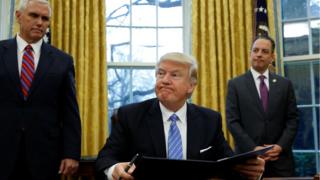 copyrighted image Reuters
copyrighted image Reuters The president of the united States, Donald Trump, signed on Monday an executive order to remove that country from the Agreement trans-Pacific Economic partnership (TPP, for its acronym in English), an ambitious and controversial treaty that seeks to give shape to the largest economic bloc in the world.
In the first full day of work of the new president in the White House, after having been sworn in as president last Friday, Trump also approved two other measures of executive:
- An order to freeze hiring of federal government, with the exception of those that carry out the Armed Forces.
- A prohibition for receiving any federal funds to the international NGOS that perform abortions or provide information on this possibility. He also denies public funding to groups that do lobby in favor of the legalization of abortion or promote it as a method of family planning.
The TPP was signed in February 2016 for 12 countries that, together, represent 40% of the global economy and nearly a third of all the flow of international trade.
Among them, there are three Latin american nations: Chile, Mexico and Peru.
The TPP was one of the central themes in the field of foreign trade of the government of former president Barack Obama, who spent some 7 years in negotiation.
a Promise kept
The output of the united States was one of the promises of Trump during the presidential campaign.
“What we just did is a great thing to the workeris americans“, said the president to sign the executive decision by which retired to his country’s trade agreement.
Before getting to the White House, Trump had said that the TPP was “a potential disaster for the country”, arguing that it would harm the manufacturing sector.
The treaty has not entered into force pending ratification by those countries that negotiated, among which are also found in Japan, Malaysia, Australia, New Zealand and Canada.
Its aim is to strengthen the economic ties and promote growth through the reduction of customs taxes.
it Also provides for measures to establish standards on labour, environmental, copyright and patents, among others.
Before the withdrawal of the united States ordered this Monday by Trump, the member countries of the TPP accounted for a third of the international trade and amounted to some 800 million people.
A decision symbolic
The signing of the executive order withdrawing the united States from the TPP is in these moments a formality, since the agreement needed to receive the approval of the Senate.
This parliamentary ratification lucia unlikely in the current political situation, due to the concern that exists in many american voters in relation to the treaties of commerce and its possible negative impact on employment.
Trump is a harsh critic of the treaties to multinational corporations, by to consider that are not complying with u.s. priorities, and place commercial interests above the generation of employment, which he considered to be a crucial bet of his government.
Farewell “asian pivot“
The TPP was the commercial arm of the so-called “asian pivot” driven by the government of Barack Obama with a view to increasing the presence of the united States in one of the areas most dynamic economic in the world and, at the same time, to prevent a vacuum in the region that could be filled by China, a country that was excluded from the TPP.
The decision of Trump puts an end to this part of the asia strategy of Obama and with a practical tool with which, according to proponents of the agreement, Washington was going to have the opportunity to write the rules of the TWENTY-first century in the Asia-Pacific.
beyond the commercial impulse, the Obama administration hoped that the TPP would serve to consolidate its relations with the countries of the region, at the same time helping to promote the american values.
“approval of the TPP is so important to me as another aircraft carrier,” he said at the time the then secretary of Defense, Ash Carter, revealing the strategic importance that it sold the agreement that has now been disposed.
Deregulation with conditions
Before signing the three executive orders listed above, the new president met with representatives of large us companies, including the manufacturer of defense systems, Lockeed Martin; appliances, Whirlpool; of the pharmaceutical sector, Johnson & Johnson; and the automotive sector, Tesla.
After the meeting, Trump warned that they warned of their intention to put a “customs tax too big” on companies that relocate their factories outside of the united States.
“we’re Going to cut the regulations so massive,” said Trump and said that the rules that are in force remain protected american citizens.
“what A company wants to lay off all its staff in the united States, building a factory in another place, and then think that your product is going to cross quietly the border to the united States? That’s not going to happen,” he said.
he Promised to reduce the rate of corporate tax from the current 35% to 15% or 20%, but he reiterated his intention of raising taxes on imported products making it clear the requirement to be met by undertakings that wish to benefit from these changes: “All you have to do is to stay (here),” he said.
No comments:
Post a Comment